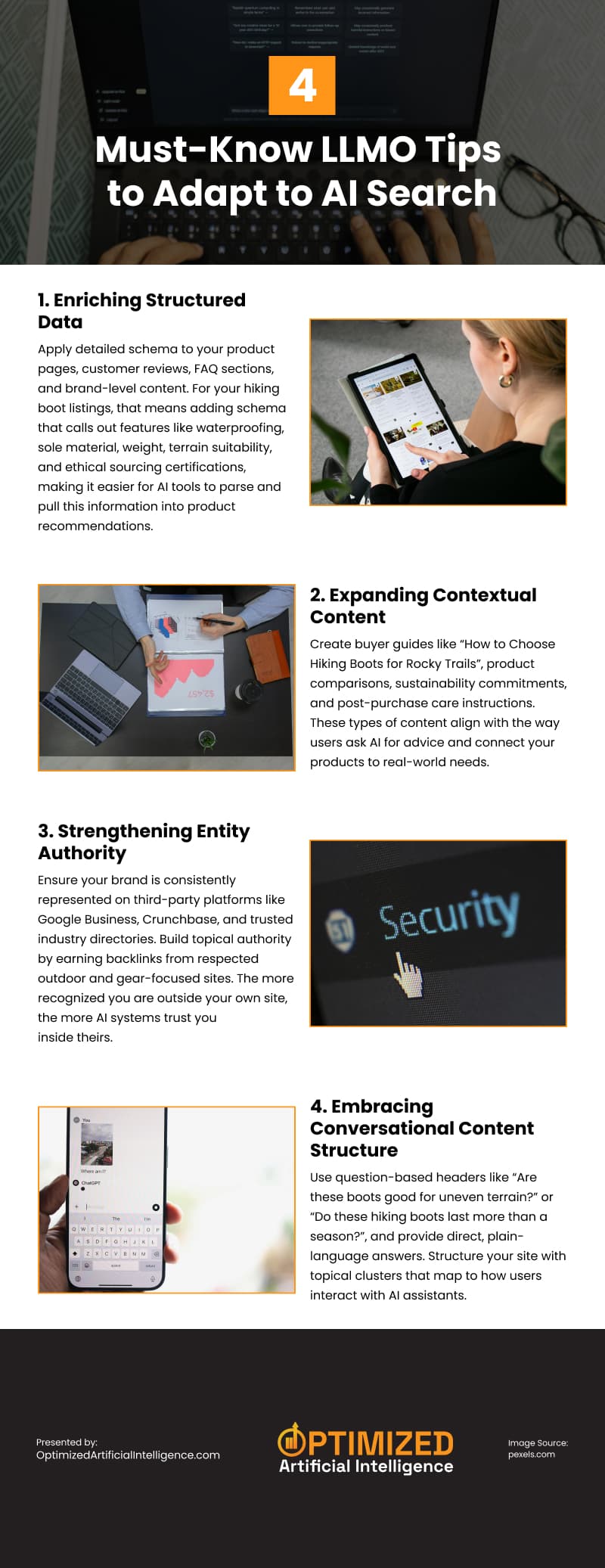If you’re running an eCommerce business, you’re already navigating a crowded digital arena. But as AI continues to reshape how people search, browse, and buy, you’re also facing a much deeper transformation: keyword-driven SEO is losing dominance.
The future of eCommerce visibility isn’t about stuffing product pages with keywords. It’s about making your brand, products, and expertise understandable, credible, and retrievable by AI systems.
Search engines are evolving from simple keyword matchmakers into sophisticated, semantic, intent-driven AI tools. Platforms like Google’s AI Overview, ChatGPT browsing, Perplexity AI, and Gemini no longer present searchers with endless blue links. They’re synthesizing information into instant summaries, product recommendations, and direct answers.

(Shoper/unsplash)
If you haven’t optimized your eCommerce content for this shift already, or you’re hesitant to use Gemini or ChatGPT search optimization strategies, you’ll find it increasingly difficult to reach customers when and where they’re ready to buy.
How Traditional Keyword Optimization Is Changing
For years, eCommerce SEO revolved around matching exact phrases that users typed into search bars. You targeted long-tail keywords like “best running shoes for women” or “buy waterproof Bluetooth speaker” and fine-tuned your meta titles, headings, and descriptions accordingly. Those tactics still matter, but not in the way you’re used to.
AI search platforms don’t solely rely on keyword matching. They interpret meaning, understand relationships between concepts, and prioritize results based on entity recognition and semantic depth. That means your carefully optimized title might not matter if AI models don’t see your brand as a trusted, contextual match for the user’s intent.
For example, if a customer asks an AI assistant, “What’s a good eco-friendly yoga mat brand for beginners?” the AI is not scanning for keyword density. It’s looking for brands with verified eco-friendly certifications, positive beginner-focused reviews, structured product data, and a recognized presence in that niche.
Your ranking position becomes irrelevant if your site lacks the machine-readable signals that connect you to that query. You simply won’t appear.
Why AI Search Rewards Semantic Understanding Over Keywords
AI search has moved beyond keyword matching. It’s now conversational, contextual, and deeply semantic. Instead of typing “cheap hiking boots,” today’s users are asking AI, “What’s a good budget-friendly hiking boot for rocky terrain that won’t fall apart after one season?”
In response, tools like ChatGPT or Perplexity aren’t scanning for exact phrases. They’re interpreting intent, pulling in reviews, evaluating materials, and selecting structured product information from trusted sources.
If your content doesn’t help AI make that judgment call, it won’t recommend you, even if you rank #3 on Google for “affordable hiking boots.” This is the new battleground: presence inside AI-driven answers, not just rankings.
To align with this shift, your eCommerce site must focus three things:
1. Entity-Based SEO
Defining your brand, products, and categories as recognized entities within your niche.
2. Topical Authority
Publishing content that explores buyer questions, product comparisons, care guides, and tutorials, not just product descriptions.
3. Structured Data
Using schema markup to help AI systems parse your offerings accurately and pull them into synthesized answers.
The eCommerce brands winning in AI search SEO aren’t stuffing keywords. They’re building deep webs of relevance that help AI understand where their products fit into broader customer needs and use cases, buying journeys, and category conversations.
4 LLMO Tips You Should Prioritize Now to Adapt to AI Search
To stay relevant, you need to reframe your eCommerce SEO strategy not for crawlers, but for retrievers and synthesizers. Large language models don’t rank, they select, and your brand must be one of the answers they trust.
Key Large Language Model Optimization (LLMO) priorities include:
1. Enriching Structured Data
Apply detailed schema to your product pages, customer reviews, FAQ sections, and brand-level content. For your hiking boot listings, that means adding schema that calls out features like waterproofing, sole material, weight, terrain suitability, and ethical sourcing certifications, making it easier for AI tools to parse and pull this information into product recommendations.
2. Expanding Contextual Content
Create buyer guides like “How to Choose Hiking Boots for Rocky Trails”, product comparisons, sustainability commitments, and post-purchase care instructions. These types of content align with the way users ask AI for advice and connect your products to real-world needs.
3. Strengthening Entity Authority
Ensure your brand is consistently represented on third-party platforms like Google Business, Crunchbase, and trusted industry directories. Build topical authority by earning backlinks from respected outdoor and gear-focused sites. The more recognized you are outside your own site, the more AI systems trust you inside theirs.
4. Embracing Conversational Content Structure
Use question-based headers like “Are these boots good for uneven terrain?” or “Do these hiking boots last more than a season?”, and provide direct, plain-language answers. Structure your site with topical clusters that map to how users interact with AI assistants.
These aren’t superficial updates. They are foundational shifts in how your brand is understood, surfaced, and recommended in an AI-first search environment.
Keyword SEO Isn’t Dead, But It’s No Longer the Game
The future of eCommerce SEO doesn’t eliminate keywords. It evolves beyond them. AI-driven search has changed how products are discovered, considered, and purchased. You’re no longer optimizing just for visibility or to rank on a list. You’re optimizing for inclusion in the answer itself.
If you want to future-proof your brand, you must think bigger than metadata fields and keyword stuffing. You must structure, substantiate, and synthesize your presence across the web so that AI systems see you, trust you, and showcase you. The brands that adapt to AI-driven search today are the ones customers will find (and buy from) tomorrow.
Infographic
To stay relevant, adapt your eCommerce SEO strategy to focus on retrievers and synthesizers—not just crawlers. Large language models now select content, so your brand must become a trusted answer. Check out this infographic for tips on optimizing for AI search.

